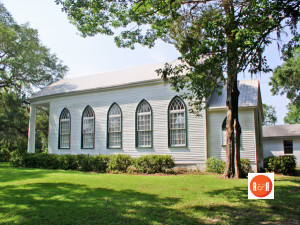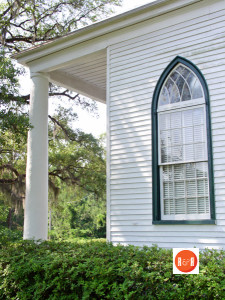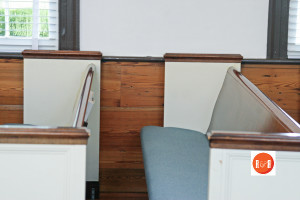9899 Highway 321
City Directories and History: “The frame church, built ca. 1847, is one bay wide and five bays deep and retains architectural features of the Greek Revival Period. Two columns support the pedimented gable roof. Influences of the Gothic Revival style appear in the form of the lancet arch above the door and windows. The interior has a central aisle flanked by pews which date from 1867.
Robertville Baptist Church was organized in 1781 as Black Swamp Baptist Church by the Rev. Alexander Scott. The name was changed in 1934 to Robertville, honoring the Robert family, all lineal descendants of Pierre Robert, Huguenot minister who emigrated to America after the revocation of the Edict of Nantes.
The present building was formerly Ascension Episcopal Church of Gillisonville, but was purchased by the Baptists about 1867 and moved to Robertville.”
Information from: Historic Resources of the Lowcountry, The Lowcountry Council of Government, Cynthia C. Jenkins, Preservation Planner – Published, 1979
ROBERTSVILLE COMMUNITY HISTORY: “John Robert was born at Jamestown, French Santee 15 July 1742, a great-grandson of the Rev. Pierre (I believe Vol. VI) states that the town of Robertville (now in Jasper County) was named for Gen. Henry Martyn Robert, Chief of Engineers, U. S. Army, and author of “Robert’s Rules of Order.” Without wishing to detract from Gen. Robert’s honor, a contributor who wishes to remain anonymous submits that this distinguished gentleman was indeed born in Robertville 2 May, 1837 (less than two decades before Col. Kilpatrick destroyed the town, burning every residence, every business, both Churches—Robertville Baptist and St. Peter’s Episcopal—and the Robertville Academy in January 1865), the fourth child of Joseph Thomas Robert, M.D. (Yale), who later became a Baptist minister and moved his family to Ohio, whence young Henry Martyn Robert entered the U. S. Military Academy at West Point, graduating in 1857. Gen. Robert’s grandfather was the Rev. James Jehu Robert, pastor of Robertville Baptist Church 1802-1852. But it was in fact the General’s great-grandfather, John Robert, who was the founder of Robertville.
John Robert was born at Jamestown, French Santee 15 July 1742, a great-grandson of the Rev. Pierre (I believe Vol. VI) states that the town of Robertville (now in Jasper County) was named for Gen. Henry Martyn Robert, Chief of Engineers, U. S. Army, and author of “Robert’s Rules of Order.” Without wishing to detract from Gen. Robert’s honor, a contributor who wishes to remain anonymous submits that this distinguished gentleman was indeed born in Robertville 2 May, 1837 (less than two decades before Col. Kilpatrick destroyed the town, burning every resi-dence, every business, both Churches—Robertville Baptist and St. Peter’s Episcopal—and the Robertville Academy in January 1865), the fourth child of Joseph Thomas Robert, M.D. (Yale), who later became a Baptist minister and moved his family to Ohio, whence young Henry Martyn Robert entered the U. S. Military Academy at West Point, graduating in 1857. Gen. Robert’s grandfather was the Rev. James Jehu Robert, pastor of Robertville Baptist Church 1802-1852. But it was in fact the General’s great-grandfather, John Robert, who was the founder of Robertville.
Robert, M.D., pastor of the French Huguenot congregation there from his arrival in South Carolina in 1686 until his death there in 1715. John Robert received a grant on the Saltkehatchie River in Colleton County 7 Oct. 1766 and settled there; on 20 Jan. 1769 he was “of Salt Catchers” when he was granted administration of the estate of William Gould, late of St. Peter’s Parish. John Robert had moved further west and was, according to Col. Isaac Hayne’s records, “of Indian Lands” when he married on 19 April 1770 Elizabeth Dixson, a granddaughter of the Second Landgrave Thomas Smith. Her father, Capt. Thomas Dixson, planter, of Long Island Plantation, James Island, was also an ordained Baptist minister which probably accounts for their founding the Robertville Baptist Church. “John Robert served in the Revolutionary War, being in Capt. Blake’s company 28 June 1778 (see S. C. Historical Magazine, “The site of Cotton Hill, the plantation whereon John Robert seems chiefly to have resided, was southeast of present Robertville at what has been known in recent decades as Pineland Club. Both John and Elizabeth Robert are buried in the Robert Cemetery, northeast of the town of Robertville, near the tomb of their eldest son, John Hancock Robert (1775-1835) whose residence was 3,528-acre Pleasant Hill Plantation northwest of Robertville. Vol. V, p. 19); he received pay for 103 days duty 16 Sept. 1779—15 Oct. 1779 and 11 Feb. 1780—12 May 1780 in Capt. Joseph Darrell’s company, for 414 days a Prisoner of War 12 May 1780—1 July 1781, and for 118 days duty 20 Sept. 1781—12 Feb. 1782.
—————–
It is reported this lovely Greek Revival Church cost only $1,800. to construct and was originally called Black Swamp Baptist.
(Information from: Names in South Carolina by C.H. Neuffer, Published by the S.C. Dept. of English, USC)
Stay Connected
Explore history, houses, and stories across S.C. Your membership provides you with updates on regional topics, information on historic research, preservation, and monthly feature articles. But remember R&R wants to hear from you and assist in preserving your own family genealogy and memorabilia.
Visit the Southern Queries – Forum to receive assistance in answering questions, discuss genealogy, and enjoy exploring preservation topics with other members. Also listed are several history and genealogical researchers for hire.
User comments welcome — post at the bottom of this page.
Please enjoy this structure and all those listed in Roots and Recall. But remember each is private property. So view them from a distance or from a public area such as the sidewalk or public road.
Do you have information to share and preserve? Family, school, church, or other older photos and stories are welcome. Send them digitally through the “Share Your Story” link, so they too might be posted on Roots and Recall.
Thanks!
IMAGE GALLERY via photographer Bill Segars – 2005









